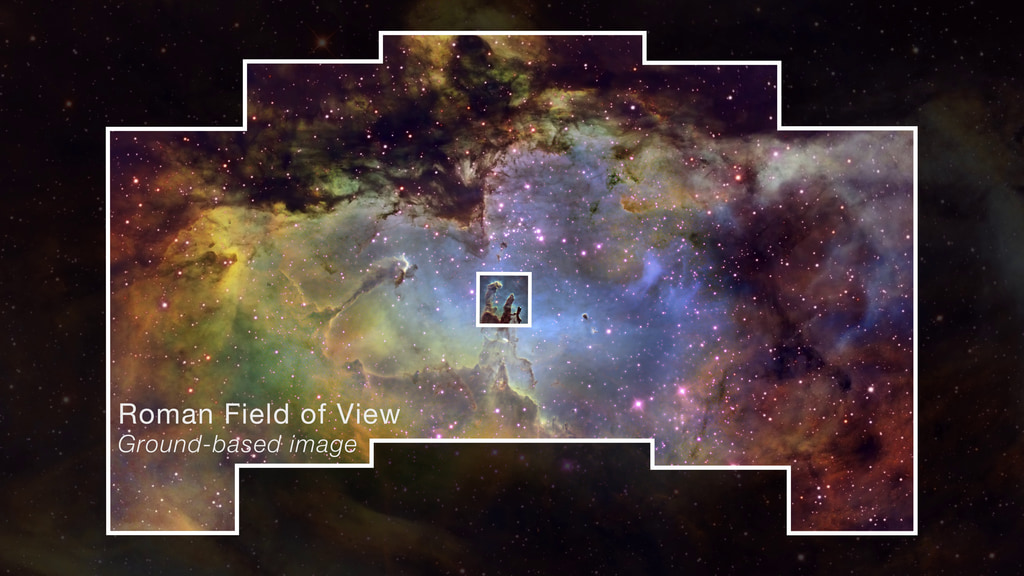The Roman Space Telescope's Immense Data Volume

This infographic showcases the difference in data volume between the Nancy Grace Roman, Webb and Hubble space telescopes. Each day, Roman will send over 500 times more data back to Earth than Hubble.
Credit: NASA's Goddard Space Flight Center

This infographic showcases the difference in data volume between the Nancy Grace Roman and Hubble space telescopes. Each day, Roman will send over 500 times more data back to Earth than Hubble.
Credit: NASA's Goddard Space Flight Center

This simulated image illustrates the wide range of science enabled by Roman's extremely wide field of view and exquisite resolution. The purple squares, which all contain background imagery simulated using data from Hubble’s Cosmic Assembly Near-infrared Deep Extragalactic Survey (CANDELS) program, outline the area Roman can capture in a single observation. An orange square shows the field of view of Hubble’s Wide Field Camera 3 for comparison. While the CANDELS program took Hubble nearly 21 days to survey in near-infrared light, Roman’s large field of view and higher efficiency would allow it to survey the same area in less than half an hour. Top left: This view illustrates a region of the large nearby spiral galaxy M83. Top right: A hypothetical distant dwarf galaxy appears in this magnified view, demonstrating Roman’s ability to detect small, faint galaxies at large distances. Bottom left: This magnified view illustrates how Roman will be able to resolve bright stars even in the dense cores of globular star clusters. Bottom right: A zoom of the CANDELS-based background shows the density of high-redshift galaxies Roman will detect.
Credit: Benjamin Williams, David Weinberg, Anil Seth, Eric Bell, Dave Sand, Dominic Benford, and the WINGS Science Investigation Team

Same as above, no labels.
Credit: Benjamin Williams, David Weinberg, Anil Seth, Eric Bell, Dave Sand, Dominic Benford, and the WINGS Science Investigation Team

This simulated image illustrates the wide range of science enabled by Roman's extremely wide field of view and exquisite resolution. The purple squares, which all contain background imagery simulated using data from Hubble’s Cosmic Assembly Near-infrared Deep Extragalactic Survey (CANDELS) program, outline the area Roman can capture in a single observation. An orange square shows the field of view of Hubble’s Wide Field Camera 3 for comparison. While the CANDELS program took Hubble nearly 21 days to survey in near-infrared light, Roman’s large field of view and higher efficiency would allow it to survey the same area in less than half an hour. Top left: This view illustrates a region of the large nearby spiral galaxy M83. Top right: A hypothetical distant dwarf galaxy appears in this magnified view, demonstrating Roman’s ability to detect small, faint galaxies at large distances. Bottom left: This magnified view illustrates how Roman will be able to resolve bright stars even in the dense cores of globular star clusters. Bottom right: A zoom of the CANDELS-based background shows the density of high-redshift galaxies Roman will detect.
Credit: Benjamin Williams, David Weinberg, Anil Seth, Eric Bell, Dave Sand, Dominic Benford, and the WINGS Science Investigation Team

Same as above, no labels.
Credit: Benjamin Williams, David Weinberg, Anil Seth, Eric Bell, Dave Sand, Dominic Benford, and the WINGS Science Investigation Team
For More Information
Credits
Please give credit for this item to:
NASA's Goddard Space Flight Center. However, individual items should be credited as indicated above.
-
Science writer
- Ashley Balzer (ADNET Systems, Inc.)
-
Producer
- Scott Wiessinger (USRA)
-
Public affairs officer
- Claire Andreoli (NASA/GSFC)
-
Designer
- Scott Wiessinger (USRA)
-
Artist
- Dominic Benford (NASA/HQ)
-
Data visualizer
- Benjamin F. Williams (University of Washington)
Release date
This page was originally published on Friday, July 24, 2020.
This page was last updated on Wednesday, May 3, 2023 at 1:44 PM EDT.
